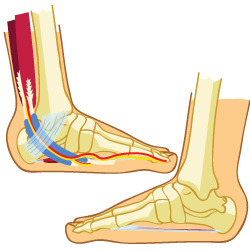
Anatomy Of The Foot
The tarsal tunnel is the space along the inside of your ankle between the heel and the top of your ankle. There are a lot of nerves, tendons, and blood vessels that run through this small "hallway" in your ankle. The tarsal tunnel bone on one side and tendon on the other that gives it its shape.
The plantar fascia is a long ligament that runs from the heel to the ball of your foot. It is one of the major elements in creating the arch of your foot. The plantar fascia serves to absorb the force of your weight as you stand, walk, jump or run.
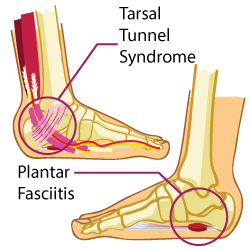
The Condition
Tarsal tunnel syndrome is like carpal tunnel syndrome in the wrist. It happens when the posterior tibial nerve gets compressed in the tarsal tunnel. When the narrow space of the tarsal tunnel becomes tight, the tibial nerve gets pinched.
Plantar fasciitis is when the plantar fascia gets swollen from overuse or an injury.
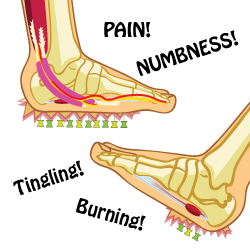
Symptoms
Tarsal tunnel syndrome usually feels like numbness on the bottom of the foot, and pain, burning and tingling on the base of the foot or heel.
With plantar fasciitis, the pain is usually concentrated around the bottom of the heel, usually near the front. The pain can often be worse first thing in the morning while taking the first few steps, or after long periods of standing or walking.
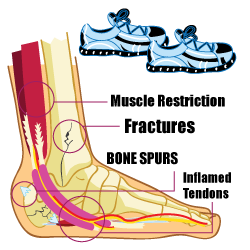
The Cause
Most of the time, it is not clear what causes tarsal tunnel syndrome. It is often associated with repeatedly performing the same motion in the feet, just like carpal tunnel syndrome in the wrist. Other contributing factors may include broken bones, bone spurs, muscle restriction, or foot deformities.
Even though plantar fasciitis is most common in middle-aged men and women, it can also be found in all age groups. As we age, our ligaments tend to get tighter and lose their elasticity. Plantar fasciitis is more common in those who are physically active - especially in runners. It happens when the plantar fascia becomes irritated and swollen, either from an injury or from being overused.
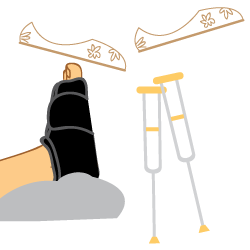
Treatment
The treatment is pretty much the same for both tarsal tunnel syndrome and plantar fasciitis. While this is not a comprehensive list, here are some of the most common treatments for these conditions. If you are looking for the full treatment list, please visit our treatment page.
- Rest: Since both of these conditions are classified as repetitive stress disorders, one of the best things to do is rest your feet. Use a pair of crutches to help you through the day while resting your feet.
- Cold Compression: Using cold compression to help reduce inflammation and pain is a great natural way to help heel your pained foot. Using cold compression instead of ice will help reduce inflammation a lot faster than just ice packs.
- Proper Shoes: Wearing shoes that have the proper support is very important in treating plantar fasciitis and tarsal tunnel syndrome. Wearing properly fitting shoes can often greatly reduce or eliminate symptoms of pain. Not only can wearing properly fitting shoes help treat these painful foot conditions, but they can also help prevent them. Look for shoes that keep your feet in correct alignment.
Full list of treatment methods can be found on our treatment page
